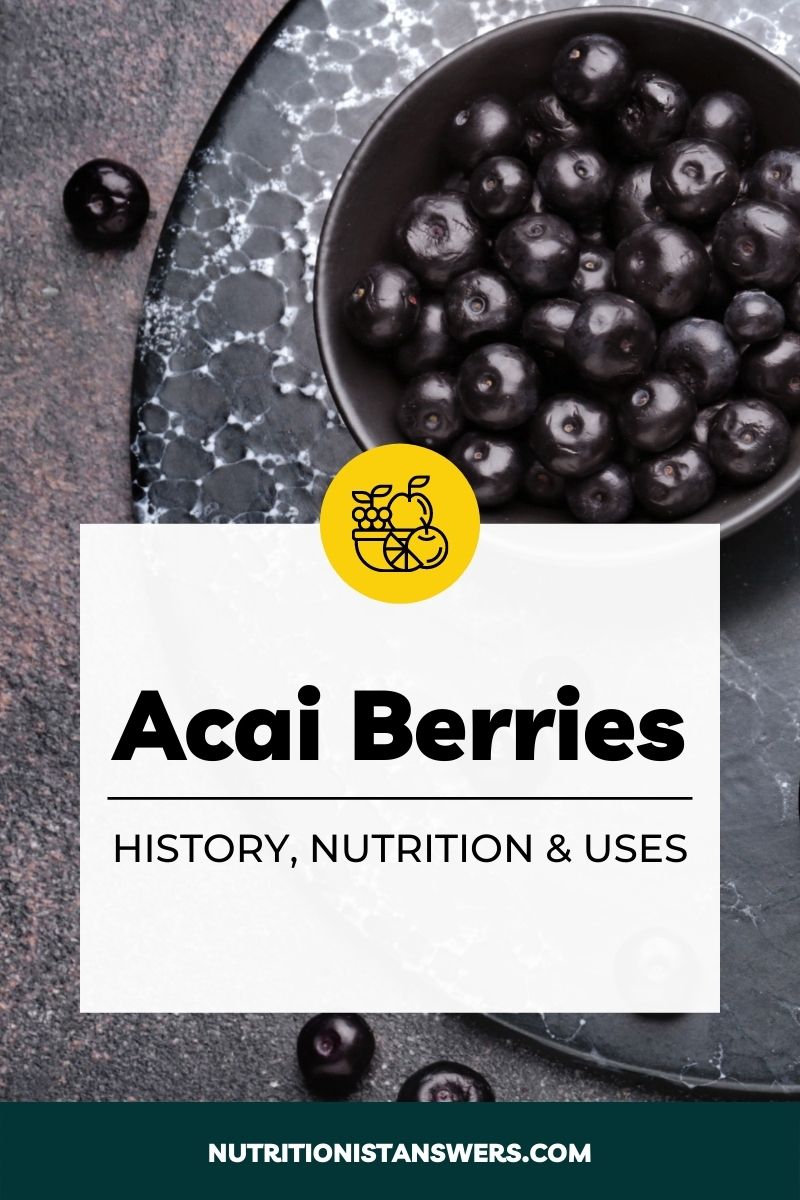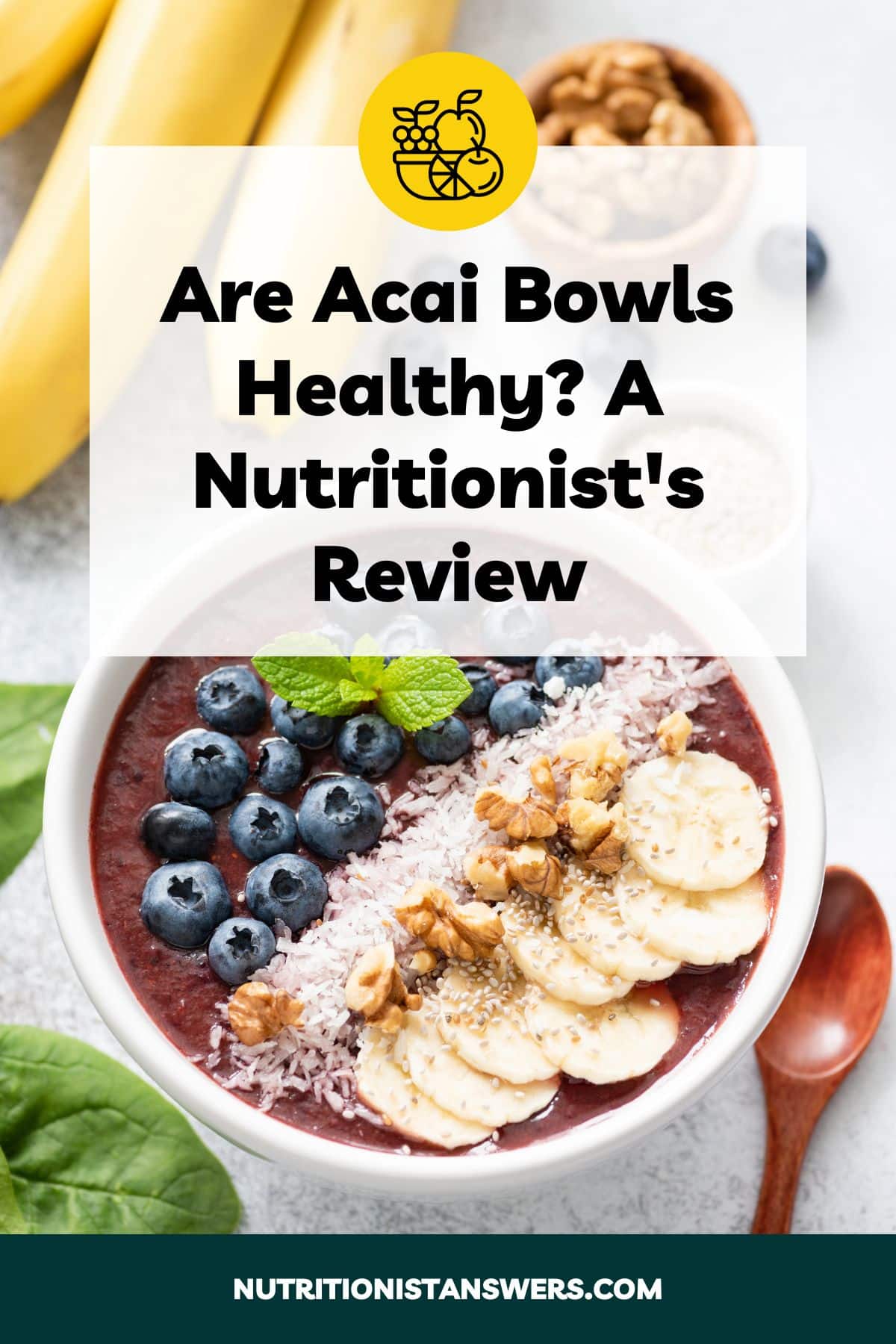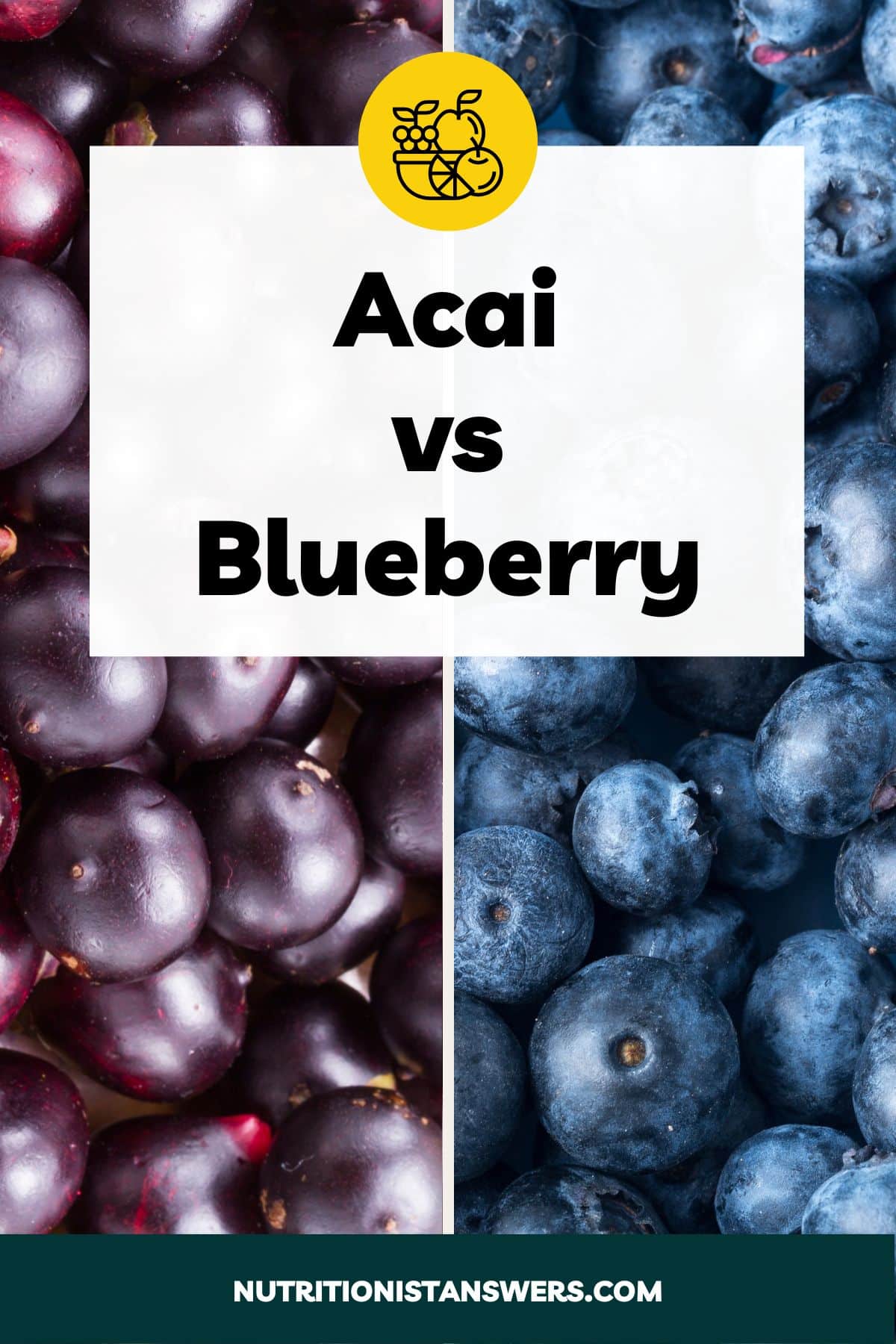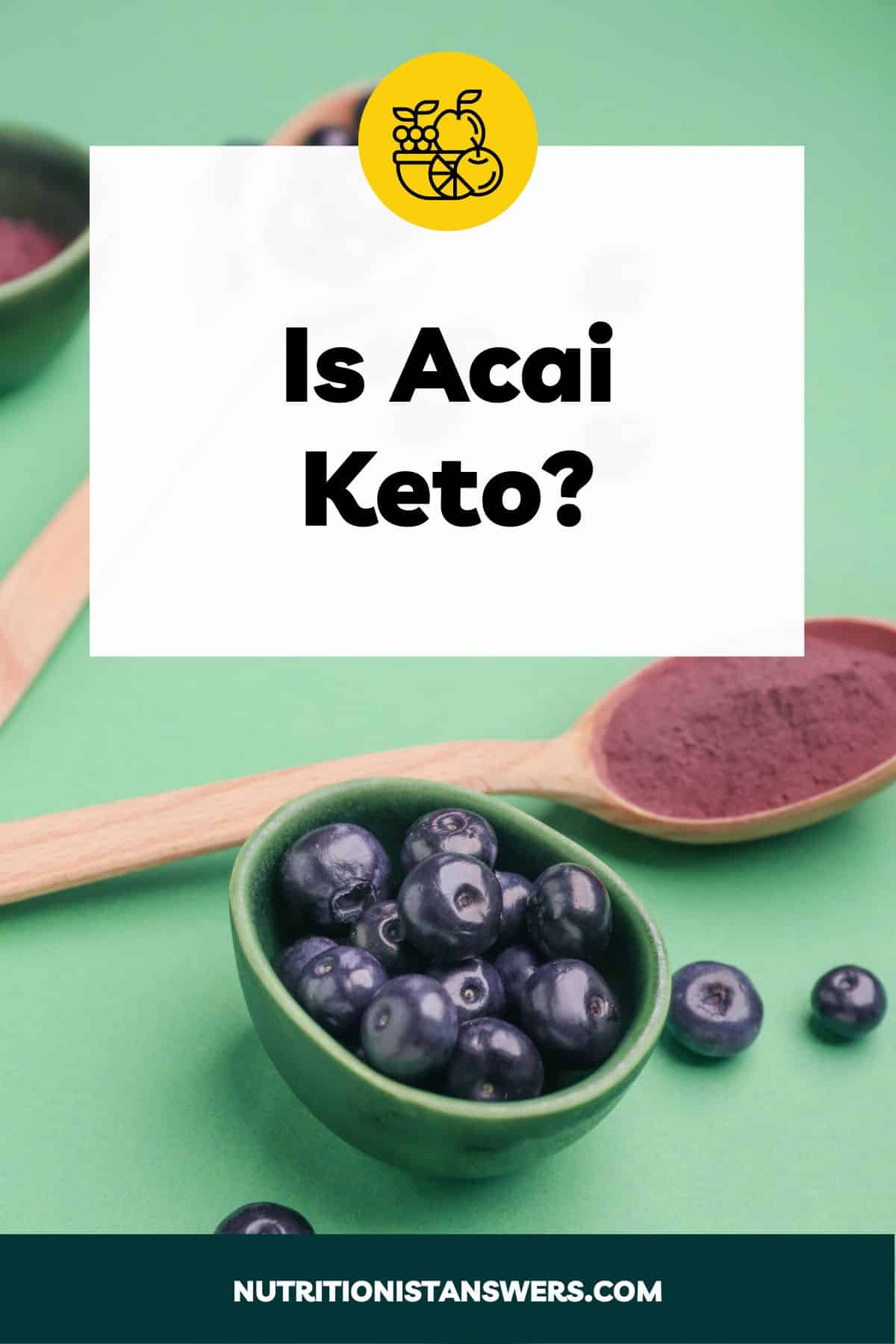Acai berries have been gaining popularity in the United States as a so-called “superfood” since they first entered the market in the early 2000s.
They are best known as the star ingredient in acai bowls, a type of smoothie that is served in — you guessed it — a bowl, and topped with fresh fruit, granola, and seeds.
But what are acai berries, and what makes them so special? Keep reading to find out!
Please note that this article contains affiliate links. If you click one of these links and make a purchase, we may earn a commission. As an Amazon Associate, we earn from qualifying purchases.
What are acai berries?
Acai berries are the fruits produced by two particular species of palm trees — Euterpe oleracea and Euterpe precatoria — also known as acai palm (1).
Acai pronunciation
Acai is pronounced “ah-sigh-ee.”
Is acai a fruit?
Acai is a fruit, and despite being referred to as a berry, it is actually a drupe (2).
Drupes (also called stone fruits) are fleshy fruits that contain a single large seed, while berries have lots of smaller seeds.
Other drupes include apricots, cherries, coconuts, dates, mangoes, olives, peaches, and plums (3).
What does acai look like?
Acai berries are small (about 1 centimeter in diameter) and round, with dark purple skin and soft, juicy flesh that surrounds a single large seed in the middle (1).
There is also a less common variety — called white acai — with bright yellow-green skin, but it’s usually not available outside of South America (4).
What does acai taste like?
Acai tastes slightly sweet and tart with an earthy or bitter undertone — its flavor is often described as a cross between blackberries, red wine, and dark chocolate.
It pairs well with other fruits, especially berries and tropical fruits like banana, mango, and kiwi, but can also be used in sauces and dressings for savory dishes.
Where does acai come from?
Acai berries are produced by acai palm trees found in the rainforests of South America (1).
They have served as a major food source for indigenous people there for centuries.
In Northern Brazil, acai is often consumed as a beverage or mixed with tapioca flour and served with meals, such as fried fish (1, 5).
Another popular dish from the Amazon region of Brazil is açaí an tigela, which means “acai in the bowl” in Portuguese.
It is made from frozen acai pulp, blended and sweetened with guarana syrup, then topped with other fruits, nuts, and seeds.
In the United States, acai pulp first arrived in the early 2000’s, and the acai bowl became trendy as a healthy breakfast or snack option.
Today, Brazil is the largest producer and exporter of acai, generating an estimated 9 billion dollars in revenue each year (4).
Where does acai grow?
Acai palm trees are grown almost exclusively in South America, mainly in floodplains along the Amazon River (1).
They look similar to other palm trees, with a slender trunk that grows to an average height of 20 meters, and large, green leaves.
What makes them unique is the clusters — each holding hundreds of acai berries — that branch out from underneath its leaves.
Acai palms are difficult to grow outside of the Amazon rainforest because they require warm, humid weather, consistently moist soil, and partial shade.
However, some plant hobbyists have been able to grow them in tropical environments with proper care.
Interestingly, acai palm trees are also harvested for hearts of palm — a tender, mild-flavored vegetable obtained from the edible inner portion of the tree’s trunk.
Acai Nutrition Facts
Calories
Acai is relatively low in calories. A 3.5-ounce (100-gram) serving of frozen acai puree provides 60-70 calories (6, 7, 8).
Macronutrients
Unlike most fruits, acai berries are low in carbohydrates, high in fat, and even provide a small amount of protein.
Here’s the macronutrient breakdown for 3.5 ounces (100 grams) frozen acai puree (6, 7, 8, 9):
- Carbohydrates: 5 grams
- Fiber: 4 grams
- Sugars: <0.5 grams
- Protein: 2 grams
- Fat: 5 grams
- Saturated fat: 1.3 grams
- Monounsaturated fat: 3.1 grams
- Polyunsaturated fat: 0.6 grams
Micronutrients
A 3.5-ounce (100-gram) serving of frozen acai pulp provides the following vitamins and minerals (6, 7, 8, 10):
- Vitamin A: 1000 IU (20% DV)
- Vitamin C: 10 mg (11% DV)
- Iron: 1.1 mg (6% DV)
- Calcium: 40 mg (3% DV)
- Potassium: 105 mg (2% DV)
Research shows that freeze-dried acai powder also provides copper, magnesium, manganese, and zinc, but it’s unclear how much is found in frozen acai pulp (5).
Acai antioxidants
Acai berries get their deep purple color from anthocyanins, a class of polyphenols with strong antioxidant properties (11, 12).
In terms of anthocyanin content, they rank fourth among berries, behind blackcurrants, blueberries, and blackberries (4).
The two main anthocyanins found in acai are cyanidin 3-glucoside and cyanidin 3-rutinoside, which may promote gut health and improve insulin sensitivity (13, 14, 15).
Other antioxidants in acai are present in smaller amounts, including the following:
- Ferulic acid, which may have benefits for skin health (1, 16)
- Lignans, a group of estrogen-like compounds with possible anti-cancer effects (17, 18)
- Resveratrol, an anti-aging compound also found in red wine (13, 19)
Acai pulp tends to have more antioxidants than acai juice but less than acai powder (20, 21).
Does acai have sugar?
Acai is naturally very low in sugar, with less than 0.5 grams per 3.5 ounces (100 grams) of frozen puree (8, 9).
The same serving size does contain about 4-6 grams of carbohydrates, but this is mostly fiber (6, 7, 8).
Does acai have protein?
Acai contains a small amount of protein — about 1-2 grams in a single 3.5-ounce (100-gram) serving of frozen acai puree (7, 8).
Does acai have iron?
Acai provides 1.1 mg (6% DV) of iron per 3.5 ounces (100 grams) of frozen puree or one tablespoon (6 grams) of freeze-dried powder (5, 7, 10).
How to select
Fresh acai berries are highly perishable, so they aren’t typically available in the United States.
Instead, they can be found in the form of frozen pulp, freeze-dried powder, juice, and premade acai bowls at many supermarkets and health food stores.
1. Frozen acai puree
The most readily available form of acai is frozen pulp that has been pureed and packaged into single-serving packets.
Frozen acai is the best choice for making acai bowls and smoothies, as well as frozen desserts like sorbets and popsicles.
Look for the following frozen acai products in the freezer section of your local supermarket:
- Acai Roots Acai Organic Pouch
- Amafruits Acai Berry Frozen Puree (contains added sugar)
- Explore Superfoods Acai Organic Berry Pulp
- Pitaya Foods Organic Acai Berry Smoothie Packs
- Sambazon Frozen Acai Superfruit Packs
- Tambor Premium Organic Traditional Acai
Note that some acai purees contain added sugar, so read labels carefully.
2. Acai berry powder
Acai powder is made from freeze-dried acai berries that have been processed into a fine powder — it is a very concentrated source of nutrients but has a milder flavor than acai puree.
This form of acai is ideal for adding to baked goods and energy bites but can also be substituted for frozen acai pulp in acai bowls and smoothies.
Check out the following acai berry powder products:
- Feel Good Organics Organic Acai Powder
- KOS Organic Acai Berry Powder
- Navitas Organic Acai Powder
- Pitaya Foods Organic Acai Berry Powder
- Terrasoul Acai Berry Powder
3. Acai berry juice
In its purest form, acai juice is made from pureed acai berries, but most brands add some sweetener or other juices to counteract the bitterness, along with preservatives like citric acid.
Acai juice can be mixed into drinks for a splash of flavor, added to smoothies, whisked into salad dressings and sauces, or even reduced to make acai syrup.
Look for acai juice at your local health food store, or purchase some online here:
4. Premade acai bowls
Most grocery stores carry premade acai bowls in the frozen section for those who need a convenient, on-the-go snack or don’t have access to a blender.
These premade options typically include acai berries blended with other fruits and topped with granola and shredded coconut.
Here are some of the most popular premade acai bowls on the market:
- Dole Acai Bowls (available in 3 flavors: Original, Protein, and Tropical)
- Good & Gather Acai Smoothie Bowls (available in 2 flavors: Tropical Dragon Fruit and Strawberry Banana)
- Sambazon Ready-to-Eat Acai Bowls (available in 3 flavors: Berry Bliss, Amazon Superberry, and Peanut Butter Power)
- Tattooed Chef Organic Acai Bowl
- Trader Joe’s Organic Acai bowl
5. Other acai products
Some less popular (but equally delicious) acai-based products, such as frozen desserts and energy drinks, are also available.
These products can be more difficult to find, but are available at certain supermarkets and can sometimes be purchased online:
- Sambazon Acai Smoothie Pops (available in 2 flavors: Blueberry Acai and Strawberry Banana)
- Sambazon Chocolate Superfruit Acai Bites
- Sambazon Original Acai Energy Drink
- Sambazon Original Acai Berry Frozen Sorbet
How to store
Acai berries are stored differently based on which form you’re using.
Store frozen acai puree in the freezer in its original packaging. Most products stay fresh for at least 3 months, but make sure to check the expiration date on the box.
Powdered acai should be kept in an air-tight container and stored out of direct sunlight in a cabinet or pantry. It can stay fresh for up to 2 years.
Unopened acai juice is shelf-stable and should be enjoyed by the best-by date printed on the bottle. After opening, store acai juice in the refrigerator and use within 7-10 days.
For other acai products, check the packaging for storage instructions.
How to prepare
1. Whip up an acai bowl or a smoothie.
Trendy acai bowls are essentially a copycat of the Brazilian dish açaí na tigela, which translates to “acai in the bowl.”
It’s made from frozen acai pulp and other fruits, blended together and topped with more fruit, granola, nuts, and seeds.
Here are some recipes to get you started:
- Acai Bowl
- Acai Smoothie
- Chocolate Banana Acai Bowl
- Oat Berry Acai Smoothie
- Peanut Butter Acai Bowl
- Raspberry Acai Bowl
- Strawberry Acai Smoothie
- Super Berry Acai Bowl
- Tropical Acai Bowl
- Vegan Acai Smoothie
2. Make refreshing frozen desserts.
Looking for a healthy, nutrient-packed dessert to help you cool down in the summer? Try using acai in sorbets, popsicles, and frozen yogurt.
Check out these delicious recipes:
- Acai Banana Nice Cream
- Acai Banana Sorbet
- Acai Berry Granita
- Acai Bowl Popsicles
- Acai Ice Popsicles
- Blueberry Acai Frozen Yogurt
- Dark Cherry Acai Vegan Frozen Yogurt
3. Give baked goods a fruity kick.
Acai can be used in all sorts of baked goods, from dessert muffins, cakes, and cookies to pancakes and waffles for breakfast.
Try adding a spoonful of acai powder to your favorite recipe — it will give the end product a deep purple color and mild, berry-like flavor.
These recipes are a good place to start:
- Acai Banana Bread
- Blackberry and Acai Berry Tartlets
- Cardamom Rose Donuts with Acai Glaze
- No-Bake Blackberry & Acai Berry Cake
- Raw Berry Acai Cheesecakes
4. Add some to oatmeal & chia pudding.
Not a fan of smoothies for breakfast? No worries! You can still enjoy acai in a bowl of oatmeal or some chia pudding.
Simply stir some thawed acai pulp or freeze-dried acai powder into your favorite recipe, or try one of these:
- Acai Blueberry Oatmeal
- Acai Overnight Oats
- Acai Yogurt Oatmeal Bowl
- Berry Chocolate Chia Pudding Parfait
- Blueberry Acai Chia Pudding
5. Make on-the-go energy bites & bars.
Packed with fiber and antioxidants, acai berries make a great addition to energy bites and bars, especially if you’re looking for a lower-carb option.
These recipes combine acai powder with nuts, seeds, and whole grains for the ideal balanced snack or dessert:
- Acai Energy Balls
- Blueberry Acai Granola Bars
- Blueberry & Acai Berry Bliss Balls
- No Bake Acai Maqui Berry Bars
- Raw Superfood Granola Bites
6. Get creative with savory dishes.
Acai is best known for being used in sweet dishes, but its tart & earthy flavor also pairs quite well with savory foods.
Try using acai pulp or powder in dressings or sauces for grilled meats, roasted vegetables, and salads.
Start with these recipes for some inspiration:
- Acai-Balsamic Glazed Roasted Root Vegetables
- Baked Sweet Potato Fries with Acai-Chili Sauce
- Super Green Salad with Acai Berry Dressing
Final Thoughts
Acai berries are popular for a reason: they’re delicious and nutritious!
Whether you enjoy them in acai bowls, frozen desserts, or baked goods, there are endless ways to incorporate this nutrient-rich fruit into your diet.
Want to learn more? Check out our full list of foods A to Z.
Amy Richter is a Registered Dietitian Nutritionist based in Missouri. She is an experienced nutrition writer and medical advisor for Healthline and Medical News Today. Amy is passionate about all things food-related and enjoys translating complex science into easy-to-understand articles.





